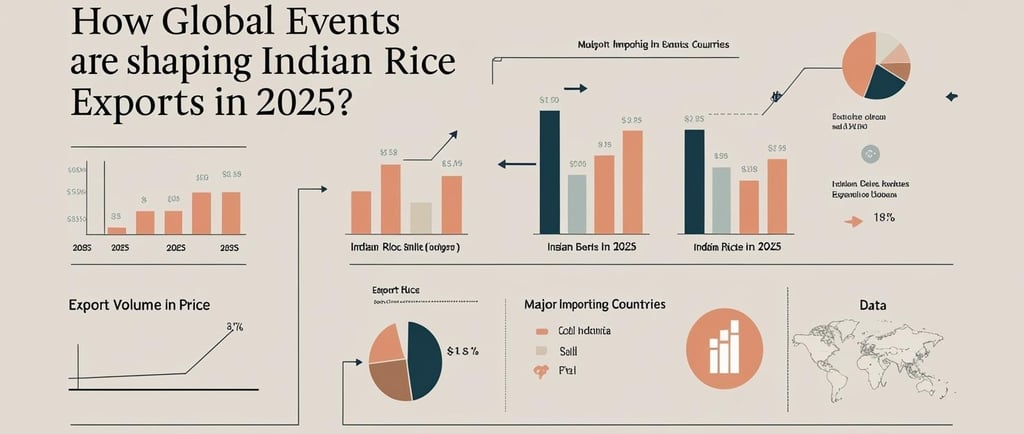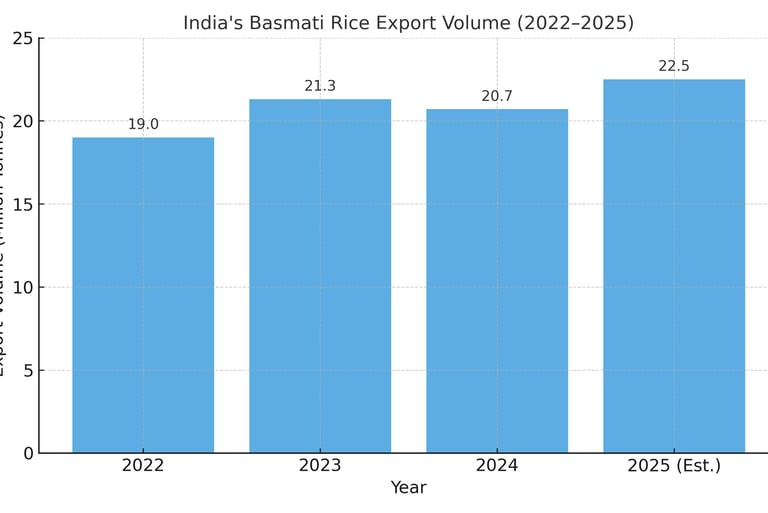Indian Rice Export Trends 2025: How Global Events Are Shaping the Market
Discover how global events in 2025 are reshaping Indian rice exports. From policy changes to rising global demand, learn what’s driving the rice trade and how exporters like SKBR Exports are adapting.
6/21/20253 min read




Indian Rice Export Trends 2025: How Global Events Are Shaping the Market
India, as the world’s leading rice exporter, faces new challenges and transitions in 2025. Global events such as changes in government policies, international conflicts, and economic shifts are significantly impacting the of rice trade. This blog simplifies these developments and . The year 2025 is redefining Indian rice exports through global fluctuations, trade restrictions, and evolving demand patterns—here's what SKBR Exports anticipates in this changing landscape.
1. India Lifts Export Duty – Good News for Buyers
Previously, Indian rice faced a 20% export duty and a Minimum Export Price (MEP) of $1200 per tonne, which made it costly in the global market. However, in early 2025, the government eliminated both restrictions.
As a result, Indian rice has become more affordable internationally.
The demand for non-basmati and parboiled rice has surged once more.
Countries such as Bangladesh, UAE, Somalia, and Kenya have significantly increased their imports.
This policy change has revitalized Indian rice's competitiveness and helped reduce the substantial stockpiles accumulated since 2023.
2. Special Support for Premium Rice (GI-Tagged)
In Budget 2025, the Indian government gave separate HS-codes to premium rice varieties like:
Joha rice (Assam)
Pokkali rice (Kerala)
Navara rice (Tamil Nadu)
These GI-tagged rice varieties now have export privileges, even during restriction periods.
For instance, the Indian government has allotted separate HS codes to premium rice varieties like GI-tagged Basmati, recognizing their distinct identity in global trade. The HS code (Harmonized System code) is a standardized classification used in customs and export documentation. Meanwhile, GI-tagged rice refers to rice grown in specific regions — like the Indo-Gangetic Plains — that have been legally recognized for their unique quality and origin. This classification ensures traceability, authenticity, and market value during exports.
Significance:
Helps protect India’s heritage rice varieties.
Encourages exports of high-value and organic rice.
Creates new opportunities for exporters targeting niche markets.
In June 2025, 10 tonnes of Joha rice were successfully exported to Dubai — proof of rising global interest in unique Indian grains.
3. Global Demand Is Rising Rapidly
Due to climate problems in other countries and population growth, global demand for rice is increasing — especially for:
Organic rice
Brown or unpolished rice
Specialty rice (low glycemic, aromatic, etc.)
Countries with rising demand:
Middle East (UAE, Qatar, Oman)
Africa (Nigeria, Ghana, Mozambique)
Europe & USA (health-conscious consumers)
This shift is great news for exporters of premium and organic rice varieties.
4. Iran Conflict Causing Delays
India exports a large amount of Basmati rice to Iran, but recent conflict in the Middle East (especially Iran-Israel tensions) has slowed exports.
Shipping delays of up to 6–8 months.
Higher insurance costs (up by 20%).
Buyers in Iran are postponing orders.
So, many exporters are shifting focus to other markets like Iraq, Saudi Arabia, and Europe.
5. Government Support & Subsidies
To encourage more agricultural exports, the Indian government is:
Reinstating RoDTEP benefits (Rebate of Duties and Taxes on Exported Products)
Offering logistic support to states like Odisha, which is emerging as a new export hub
Promoting exports of rice through digital tracking, APEDA listings, and free trade zone access
Frequently Asked Questions
Q1: Will Indian rice stay affordable this year?
Yes. With the removal of duties and improved crop yield, prices are stable for now.
Q2: Can you supply organic or GI rice?
Absolutely. We offer certified organic rice and GI-tagged varieties like Joha and Navara.
Q3: What about shipment delays in the Middle East?
We’re offering flexible shipping routes and targeting alternative buyers to ensure timely delivery
Conclusion
2025 has been a game-changing year for the Indian rice export industry. From government support to global demand, Indian exporters now have more opportunities — but also new challenges. Staying informed and adapting quickly is the key to success.
At SKBR Exports, we’re fully prepared to serve global markets with high-quality rice, backed by government incentives and real-time market intelligence.
more on choosing the right rice type for export, read our post on [Basmati vs Non-Basmati Rice].”
Want to Import Quality Indian Rice?
Visit www.skbrexports.com
📩 Or email us at info@skbrexports.com for export enquiries.
